Mulberry Trees: White, Red, Black – With Flowers and Leaves (Pictures)
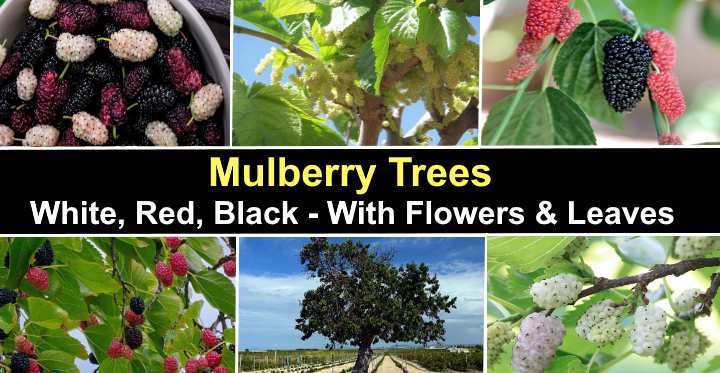
Mulberry trees (botanical name Morus) are popular ornamental shade trees that produce delicious edible white, red, or black berries. Commonly called mulberries, the medium-sized, berry-producing trees have attractive heart-shaped leaves, spikes of tiny white flowers (catkins), and thick grayish-brown bark. The common species of mulberry trees are red mulberry, white mulberry, and black mulberry.
Mulberry trees are popular in garden landscapes because they are attractive trees, easy to grow, and produce deliciously sweet berries. The common mulberry thrives in USDA zones 4 through 9, full to partial sun, and well-drained soils. In addition, the mulberry tree is relatively resistant to pests and disease.
How can you identify mulberry trees in a landscape? Why are mulberries popular residential garden trees? This guide to mulberry trees answers questions relating to mulberry identification and how to grow this ornamental tree.
Common Types of Mulberry (Morus)
There are three principal species of mulberry trees, generally identified by their fruit color, leaf shape, and bark. Additionally, there are many mulberry cultivars, such as the weeping mulberry tree, fruitless mulberry tree, and dwarf mulberry tree.
Here are brief descriptions of the most common mulberry trees:
Red mulberry (Morus rubra): This species of mulberry is native to North America. It grows in moist, deep, well-draining soil. The red mulberry has a rounded crown, a short trunk, small white spring flowers, sweet, juicy red or black berries, and leaves of varying shapes.
White mulberry (Morus alba): This mulberry species is native to the Far East but is popular in Europe and North America. The blackberry-like edible fruits are white when immature and turn pink or purple as they ripen. The white mulberry has heart-shaped, toothed leaves.
Black mulberry (Morus nigra): The black mulberry is a deciduous, medium-sized, fast-growing tree with heart-shaped serrated leaves with tasty mulberry berries.
About Mulberry Trees
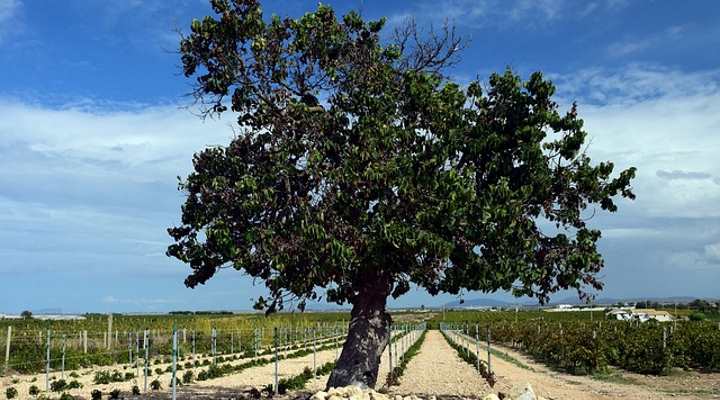
Old mulberry tree
Mulberry is a species of deciduous tree in the genus Morus and woody plant family Moraceae. Mulberries are berry-producing trees that have a fast growth rate and are easy to grow in most environments.
The mature size of mulberries depends on the species. White mulberry is the tallest at 80 ft. (24 m), and the common red mulberry grows up to 70 ft. (21 m). The black mulberry is the smallest species, with a height of around 30 ft. (9 m).
For a smaller garden tree, the dwarf mulberry is ideal for containers, and the bushy plant grows 2 to 6 ft. (0.6 – 1.8 m) tall.
Apart from its ornamental value, a mulberry tree is prized for its sweet, tasty fruits. The mulberry berries look like elongated blackberries. The berries from red and black mulberries are sweeter than the white mulberries. However, black mulberries tend to succumb to drought or frost damage easier. Because these soft mulberry fruits don’t travel well, you rarely find mulberry berries in stores.
Many people remember the childhood song “All Around the Mulberry Bush,” where the monkey chased the weasel. However, no plant is classified as a mulberry bush. Only the dwarf mulberry is a small tree with bush-like growth. Or you can prune a black mulberry to grow like a bush.
How to Care for Mulberry Trees
Grow mulberry trees in full sun and fertile, humus-rich soil that drains well. Ideally, plant mulberries 15 ft. (5 m) apart to allow for their large spread. Also, ensure the planting location is deep enough as mulberry trees have a deep root system that is excellent for erosion control.
Mulberries adapt well to most soil types.
Mulberry Leaf
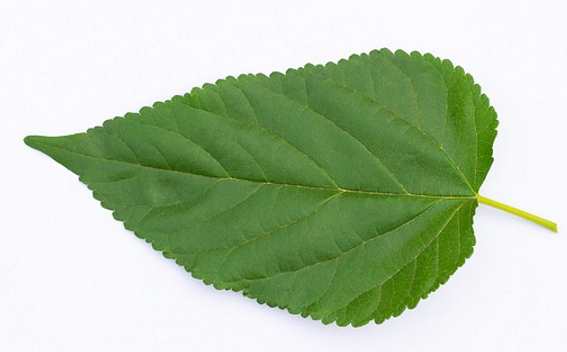
Mulberry leaf
Mulberry tree leaves are large, broad cordate (heart-shaped) leaves with serrated margins. The simple mulberry leaves grow alternately on branches and measure between 3” and 6” (7.5 – 15 cm) long and 2” to 4” (5 – 10 cm) wide. In the fall, the green foliage turns golden yellow before the leaves drop.
An unusual feature of some mulberry tree species is that leaves on a single tree can have different shapes. For example, red mulberry and black mulberry leaves can have two to three deep lobes or none. Some leaves may resemble maple or sycamore tree leaves, and others have a single lobe on one side of the blade.
Mulberry Fruit (Mulberry Berries)
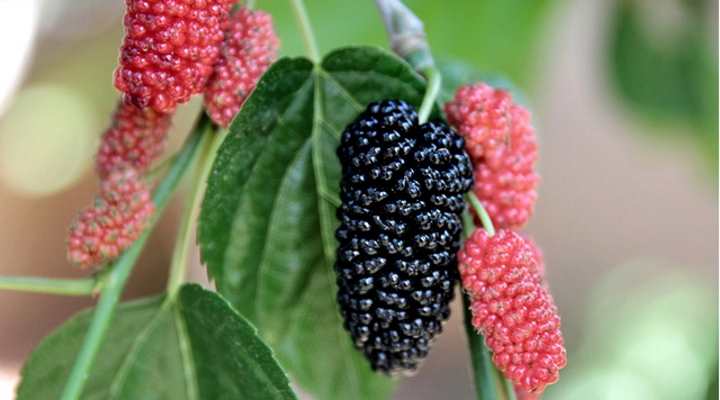
Mulberry fruits are berry-like drupes
Mulberry berries are drupes that look like long blackberries. The ripe black, purple, or red berry-like drupes grow between 1” and 3” (2.5 – 7.5 cm) long. The deliciously tasty berries ripen in summer and drop to the ground as they are ready for eating.
If you have a mulberry tree growing in your backyard, you will get tons of berries from the tree. The berries can be eaten fresh, and are suitable for making jellies, jams, pies, or tarts. Additionally, the white, red, and black mulberry berries attract plenty of birds to your summer garden.
One issue with berries falling from mulberry trees is that they can cause a mess. If you want to plant a mulberry tree, don’t plant it near sidewalks or driveways. However, you could grow a fruitless mulberry tree that isn’t messy because it doesn’t produce flowers or fruit.
Mulberry Flower
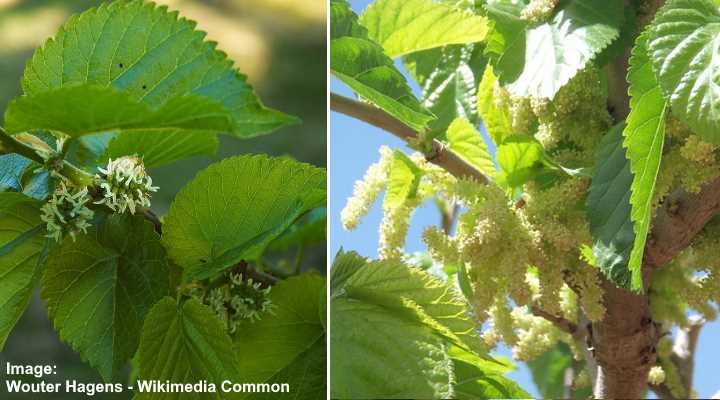
Mulberry female flowers (left) and male flowers (right)
Mulberry tree flowers are insignificant clusters of tiny white or green flowers growing on a short spike or catkin. Mulberry trees bloom in spring and are small spiky flower clusters. Male flowers are narrower and longer. Male and female flowers can grow on a single mulberry tree, or a tree can bear only male or female flowers, however only female flowers produce fruit.
After blooming in May, mulberry flowers develop into a cluster of tiny, seeded fruits that make up the berries.
Mulberry Identification
Identifying mulberry trees is by their leaves, spread, fruit, and bark. Mulberry leaves are identified by their heart shape with serrated edges and a pointed tip. A recognizable feature of mulberries is their red, purple, white, or black berries. In landscapes, mulberries are the last trees to produce leaves.
Types of Mulberry Trees
Let’s look in detail at six common types of mulberry trees. As well as the common mulberries—red, white, and black varieties—we’ll look at some common cultivars for planting in your backyard.
White Mulberry (Morus alba)

White mulberry tree (Morus alba)
The white mulberry is a fast-growing deciduous tree. It is identified by glossy dark-green tooth-edged leaves, small green flower spikes, sweet berry-like fruits, and dark brown furrowed bark. White mulberries have a wide-spreading rounded, irregular crown that can be as wide as the tree is tall.
The white mulberry thrives in USDA zones 4 through 8 in full sun. The hardy tree grows between 30 and 50 ft. (9 – 15 m) tall and wide and is ideal as a shade tree thanks to its large-leafed foliage. The tree grows well in landscapes; however, it can be messy and doesn’t have much ornamental value.
Other uses for a white mulberry tree in a large front or backyard include a windbreak, soil erosion control, or grown for its fruits.
The white mulberry also has the name silkworm mulberry. This name comes from its native China, where it was cultivated to nourish silkworms. It is also called the common mulberry; however, that name usually refers to the red mulberry species.
The name white mulberry doesn’t refer to the color of its edible berries. The drupes can be white, pink, dark red, or deep purple colors.
There are a few ways to tell white mulberries apart from black and red mulberries. First, leaves on white mulberries are glossier than red mulberries. In addition, the fruit is sweet but lacks the intensity of black and red mulberries.
Mulberry leaves: White mulberry leaves are heart-shaped with serrated, uneven margins. The leaves grow up to 8” (20 cm) long and may have two or three irregular lobes. In the fall, the mulberry leaves turn an unattractive yellow or light brown color.
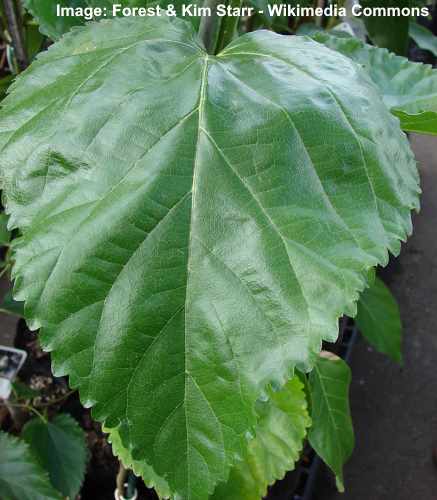
White mulberry leaf
Mulberry fruit:White mulberry fruits are small and edible, about 1-inch (2.5 cm) long. They ripen in the summer, changing colors from pink to red, and then to purple-black. Unlike the richer black and red mulberries, white mulberries have a milder, less intense flavor.
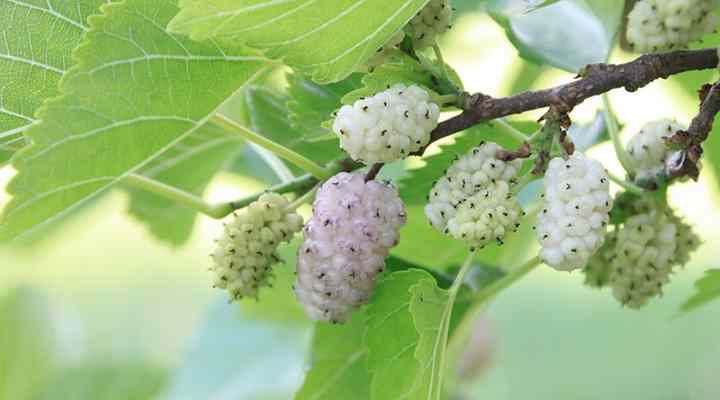
White mulberries mature to pink, red or purple-black fruits
Mulberry flower: Male and female flowers are called catkins. Male catkins are yellowish-green and measure ¾ – 2 inches long (2 – 5 cm). Female catkins are green with white ‘hairs’, shorter and more oval.

White mulberry female flowers
Red Mulberry (Morus rubra)
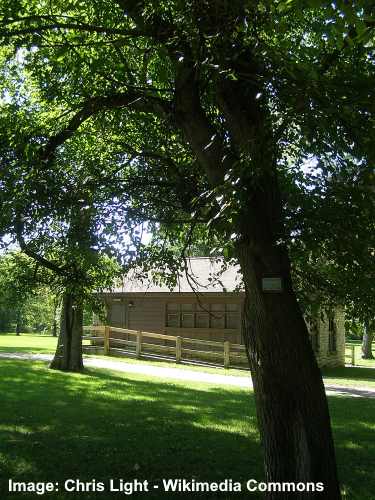
Red mulberry tree (Morus rubra)
The red mulberry is a medium-sized deciduous tree native to North America. Also called common mulberry, the tree is identified by ovate-shaped dark-green lobed leaves, sweet edible berries, small cylindrical greenish flowers, and smooth reddish-brown bark. In landscapes, you can spot the tree by its broad rounded crown.
Red mulberry trees thrive in full sun but also grow well in partial shade. Suitable for USDA zones 4 to 8, the hardy tree is famed for its delicious soft fruits that are extremely sweet and tasty. Thanks to its flowers and fruit, the mulberry attracts butterflies, birds, and other wildlife.
Red mulberry flowers are insignificant greenish catkins that bloom from April to May. The small tubular flowers grow up to 1” (2.5 cm) long but are hard to spot among the large, broad leaves.
Red mulberry bark is smooth and dark brown to dark gray. The tree bark can develop shallow ridges that have a reddish color. Branches and stems tend to be reddish-brown.
An identifying feature of the red mulberry is the unusually shaped leaves. Red mulberry leaves are generally heart-shaped with a rounded base. However, leaves can have several deep lobes, giving the green blade an uneven appearance. Leaves can look like simple birch tree leaves with a pointed tip or have deeply lobed leaves like a maple tree.
Mulberry leaves: Red mulberry tree leaves are cordate shaped with finely-toothed margins. Leaves can have several lobes or have no lobes, and they tend to be slightly hairy. Red mulberry leaves grow 6” (15 cm) long and 3” to 6” (7.5 – 15 cm) wide.
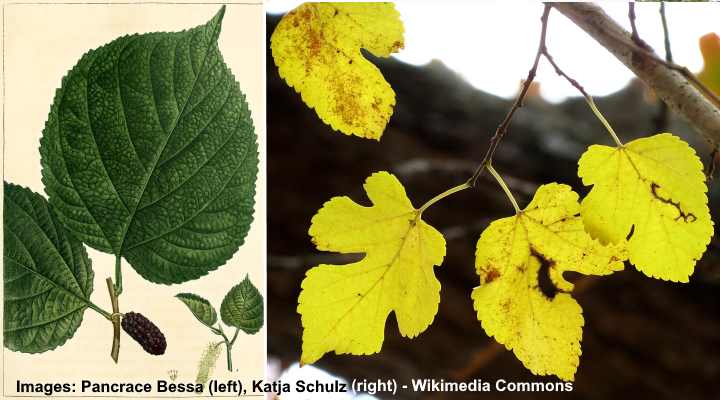
Red mulberry leaves
Mulberry fruit: Red mulberry tree berries are sweet and juicy and look like oversized blackberries. The mulberry fruits mature in summer and are dark purple when ready for eating.
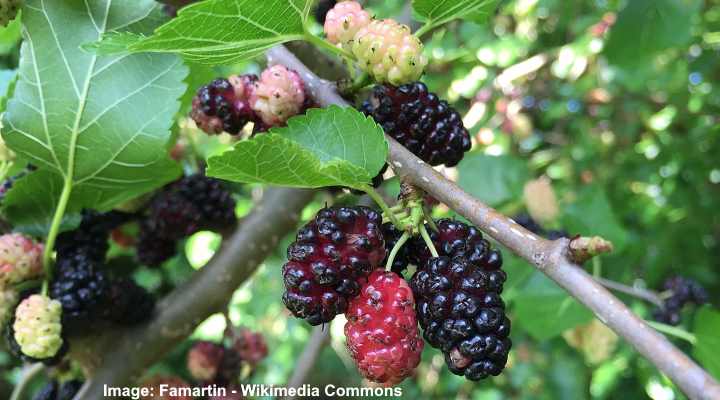
Red mulberry fruit
Black Mulberry (Morus Nigra)
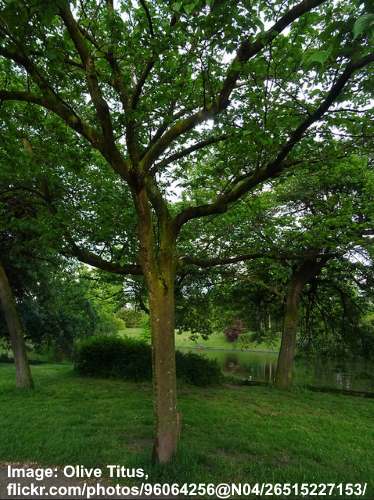
Black Mulberry tree (Morus nigra)
The black mulberry is the smallest of the common mulberry trees. Black mulberries in landscapes are identified by pointed ovate dark-green leaves, greenish flowers, and red, white, or black fruit. From the mulberry species, the black mulberry is the one that has the bushiest growth.
The black mulberry grows in USDA zone 5 through 9 and grows best in full sun. Unlike the other common mulberries, the black mulberry doesn’t tolerate too much shade or extremely cold conditions.
Black mulberry flowers are inconspicuous catkins consisting of small tubular white flowers. The mulberry tree blooms in spring. After blooming, the tasty edible berries appear and ripen during summer.
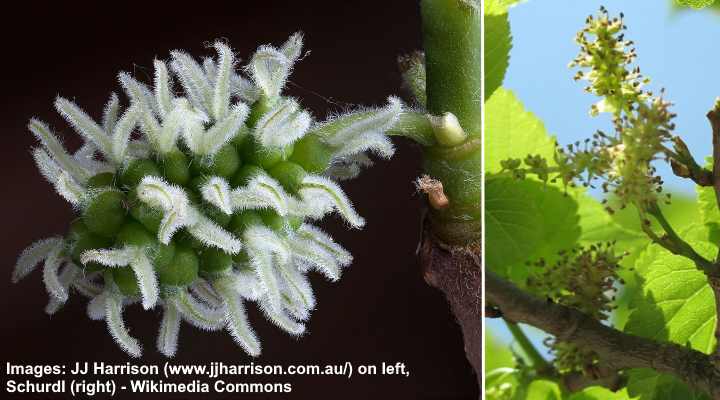
Black mulberry female flower (left) and male flowers (right)
Black mulberry tree bark is a light-brown color with narrow fissures on it. You may find that in time the trunk develops gnarls and large burrs. The interesting bark texture gives the black mulberry plenty of winter appeal after the tree drops its leaves.
Mulberry leaves: Black mulberry tree leaves are broad, simple, attractive leaves that grow 4” to 8” (10 – 20 cm) long and up to 4” (10 cm) broad. The leaves of mulberry leaves are identified by a rough texture, stiff hairs, and finely serrated margins.
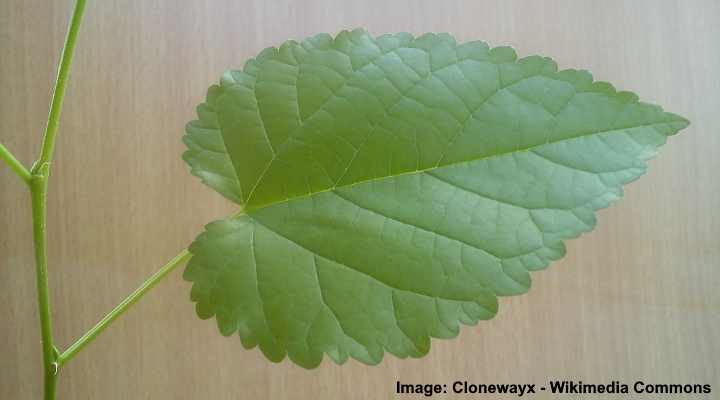
Black mulberry leaf
Mulberry fruit: Black mulberry tree berries are clusters of small black drupes that measure 1.2” (3 cm) long. The richly flavored soft, juicy fruits taste like red mulberry berries.
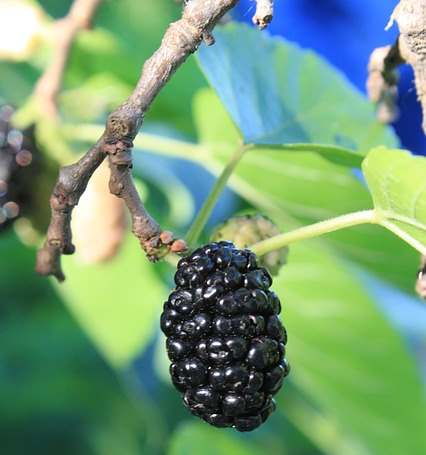
Black mulberry fruit
Weeping Mulberry (Morus alba ‘Chaparral’ and Morus alba ‘Pendula’)
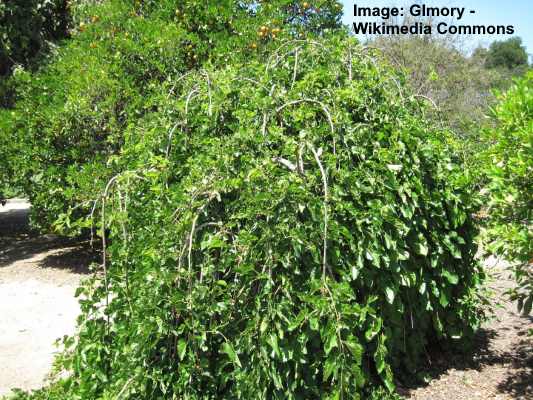
Weeping mulberry (Morus alba ‘Pendula’)
Weeping mulberry trees are elegant landscaping trees with arching branches that droop to the ground. The weeping mulberry has a neat, rounded crown, small yellowish-green flowers, heart-shaped leaves, and sweet edible white or pink fruits. Weeping mulberries are suitable for small gardens or as a specimen plant.
Because most weeping mulberries are cultivars of Morus alba, they have the same leaf, bark, and fruit identification characteristics as white mulberries. The only difference is their weeping growth and shorter growth stature.
Here are the two weeping mulberry cultivars of the white mulberry Morus alba:
Morus alba ‘Chaparral’ is a fruitless weeping mulberry tree with a rounded, spreading canopy and drooping branches. This mulberry cultivar grows 6 to 8 ft. (1.8 – 2.4 m) tall and up to 12 ft. (3.6 m) wide. This tree produces yellowish-green male catkins that don’t bear fruits.
Morus alba ‘Pendula’ is a fruiting weeping mulberry tree with the characteristic sweet blackberry-like white, red, or purple fruits and glossy dark-green pointed ovate leaves. The weeping mulberry ‘Pendula’ grows 6 to 10 ft. (1.8 – 3 m) tall and up to 12 ft. (3.6 m) wide.
Mulberry leaves: Weeping mulberry tree leaves have serrated uneven margins and usually two to three lobes. The rounded leaves have a pointed tip and glossy green shine.
Mulberry fruit: Weeping mulberry tree berries are sweet, cylindrical drupes up to 1” (2.5 cm) long. The white, pink, red, or black berries have a sweet taste but lack the intensity of black or red mulberry fruits.
Fruitless Mulberry (Morus alba ‘Fruitless’)
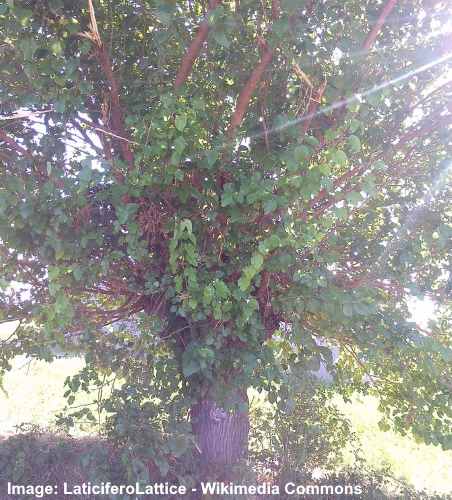
Fruitless mulberry (Morus alba ‘Fruitless’)
Fruitless mulberry trees have broad, heart-shaped pointed, glossy green leaves, light orange-brown bark, and small greenish flower clusters. Fruitless mulberries are ideal for landscaping as they are easy to grow, require little pruning, and don’t produce messy fruit. Additionally, fruitless mulberries are less invasive than the fruiting varieties.
If you’re looking for an ornamental landscaping mulberry tree that’s not messy, then the Morus alba ‘Fruitless’ cultivar is ideal. This non-messy mulberry grows 20 to 60 ft. (6 – 18 m) and up to 54 ft. (14 m) wide.
Here are some suitable mulberry cultivars that don’t produce berries:
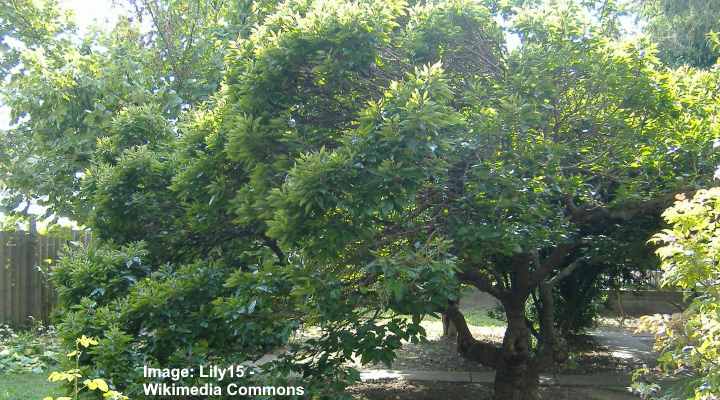
Morus alba ‘Fegyverneken’
- White mulberry ‘Fegyvernekiana’—grows up to 4 ft. (1.2 m) high.
- White mulberry ‘Bellaire’—a medium-sized mulberry growing 30 to 50 ft. (5 – 15 m) tall.
- White mulberry ‘Hempton’
- White mulberry ‘Urban’
- White mulberry ‘Stribling’—grows 30 to 50 ft. (5 – 15 m) high.
Dwarf Mulberry Tree
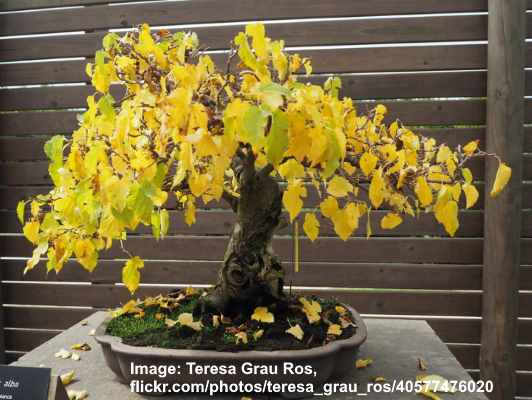
Mulberry (Morus alba) bonsai tree
The dwarf mulberry tree is a bush-like tree that grows well in containers and garden landscapes. Like most mulberries, the dwarf variety has leathery green leaves, dark red or black summer fruits, and smooth brown or gray bark. A dwarf mulberry can be a multi-stemmed shrub-like tree or a single-stemmed specimen tree.
Dwarf mulberries are suitable for growing in containers. Growing in pots and with the proper pruning, a small mulberry grows 2 to 6 ft. (0.6 – 1.8 m) tall. Grow in a well-draining potting mix and full sun.
Another type of dwarf mulberry tree that is shorter than a traditional mulberry is the everbearing mulberry. The dwarf variety grows between 10 and 15 ft. (3 – 4.5 m) tall and up to 20 ft. (6 m) wide. Like all mulberries, the dwarf everbearing mulberry has juicy red or black fruits.
Miniature mulberry trees also grow as spectacular bonsai trees. Mulberry bonsai trees have characteristic gnarled trunks, small pointed ovate leaves, and produce medium-sized fruits.
Related articles:
- Trees and Shrubs with Red Berries
- Sumac Trees: Types, Leaves, Berries – Identification
- Serviceberry Trees and Shrubs – Identification
